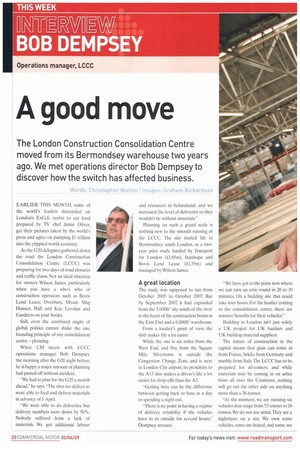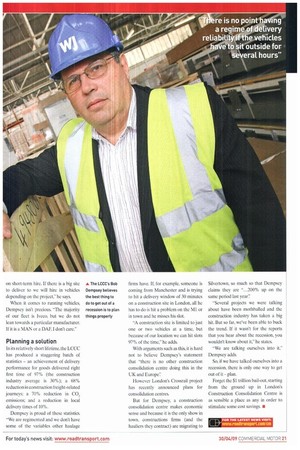A good move
Page 20

Page 21

If you've noticed an error in this article please click here to report it so we can fix it.
The London Construction Consolidation Centre moved from its Bermondsey warehouse two years ago. We met operations director Bob Dempsey to discover how the switch has affected business.
Lhristopher Walton/ 1fild9eb. uraflain rtichardsoft EARLIER THIS MONTH, some of the world's leaders descended on London's ExCeL centre to eat food prepared by TV chef Jamie Oliver, get their pictures taken by the world's press and agree on pumping $1 trillion into the crippled world economy.
As the 020 delegates gathered, down the road the London Construction Consolidation Centre (LCCC) was preparing for two days of road closures and traffic chaos. Not an ideal situation for owners Wilson James, particularly when you have a who's who of construction operators such as Bevis Lend Lease, Overbury, Mivan, Mag Hansen, Hall and Kay. Levolux and Gardners on your books.
Still, even the combined might of global politics cannot shake the one founding principle of any consolidation centre — planning.
When CM meets with LCCC operations manager Bob Dempsey the morning after the G20 night before, he is happy a major amount of planning had passed off without incident.
We had to plan for the 020 a month ahead," he says. "The sites we deliver to were able to feed and deliver materials in advance of 1 April.
"We were able to do deliveries, but delivery numbers were down by 50%. Nobody suffered from a lack of materials. We got additional labour and resources in beforehand, and we increased the level of deliveries so they wouldn't be without materials."
Planning on such a grand scale is nothing new to the smooth running of the LCCC. The site started life in Bermondsey, south London, as a twoyear pilot study funded by Transport for London (£1.85m), Stanhope and Bovis Lend Lease (11.35m) and managed by Wilson James.
A great Location
The study was supposed to run from October 2005 to October 2007 But by September 2007, it had expanded from the 5,000ft= site south of the river to the heart of the construction boom in the East End and a 6,000ft= warehouse.
From a haulier's point of view, the shift makes life a lot easier.
While the site is six miles from the West End, and five from the Square Mile, Silvertown is outside the Congestion Charge Zone and is next to London City airport; its proximity to the A13 also makes a driver's life a lot easier for drop-offs than the A2.
"Getting here can be the difference between getting back to base in a day or spending a night out.
"There is no point in having a regime of delivery reliability if the vehicles have to sit outside for several hours," Dempsey stress. "We have got to the point now where we can turn an artic round in 20 to 30 minutes. On a building site that could take four hours. For the haulier coming to the consolidation centre, there are massive benefits for their vehicles."
Building in London isn't just solely a UK project for UK hauliers and UK building material suppliers.
The nature of construction in the capital means that glass can come in from France, bricks from Germany and marble from Italy. The LCCC has to be prepared for all-comers, and while materials may be coming in on artics from all over the Continent, nothing will go out the other side on anything more than a 26-tonner.
"At the moment, we are running six vehicles that range from 7.5 tonnes to 26 tonnes. We do not use artics. They are a nightmare on a site. We own some vehicles, some are leased, and some are on short-term hire. If there is a big site to deliver to we will hire in vehicles depending on the project," he says.
When it comes to running vehicles, Dempsey isn't precious. "The majority of our fleet is lveco, but we do not lean towards a particular manufacturer. If it is a MAN or a DAF, I don't care."
Planning a solution In its relatively short lifetime, the LCCC has produced a staggering batch of statistics an achievement of delivery performance for goods delivered right first time of 97% (the construction industry average is 30%); a 68% reduction in construction freight-related journeys; a 70% reduction in CO, emissions; and a reduction in local delivery times of 10%.
Dempsey is proud of these statistics. "We are regimented and we don't have some of the variables other haulage firms have. If, for example, someone is coming from Manchester and is trying to hit a delivery window of 30 minutes on a construction site in London, all he has to do is hit a problem on the MI or in town and he misses his slot.
"A construction site is limited to just one or two vehicles at a time, but because of our location we can hit slots 97% of the time," he adds.
With arguments such as this, it is hard not to believe Dempsey's statement that "there is no other construction consolidation centre doing this in the UK and Europe': However London's Crossrail project has recently announced plans for consolidation centres.
But for Dempsey, a construction consolidation centre makes economic sense and because it is the only show in town, constructions firms (and the hauliers they contract) are migrating to Silvertown, so much so that Dempsey claims they are -...200% up on the same period last year" "Several projects we were talking about have been mothballed and the construction industry has taken a big hit. But so far, we've been able to buck the trend. If it wasn't for the reports that you hear about the recession, you wouldn't know about it," he states.
"We are talking ourselves into it," Dempsey adds.
So. if we have talked ourselves into a recession, there is only one way to get out of it plan.
Forget the $1 trillion bail-out, starting from the ground up in London's Construction Consolidation Centre is as sensible a place as any in order to stimulate some cost savings. •












































































































































